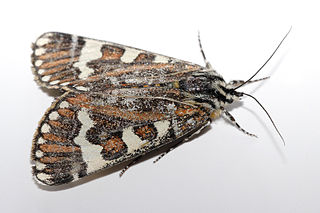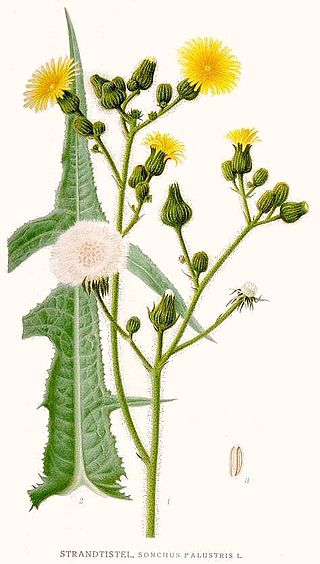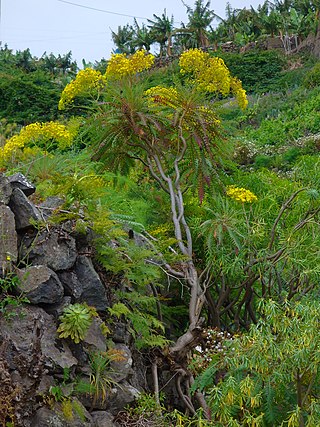

Sow thistle most often refers to yellow flowered, thistle-like plants in the genus Sonchus.
Sow thistle may also refer to:
- Cicerbita , a genus of plants related to Sonchus, with blue, white, or yellow flowers.


Sow thistle most often refers to yellow flowered, thistle-like plants in the genus Sonchus.
Sow thistle may also refer to:

The pasture day moth is a species in the moth family Noctuidae which is active during the day, as its common name implies, making it unlike most other noctuid species. It is found in most southern areas of Australia, ranging from lower Queensland to Tasmania. The species was first described by George French Angas in 1847. It is the only species in the monotypic genus Apina, erected by Francis Walker in 1855.

Sonchus is a genus of flowering plants in the tribe Cichorieae within the family Asteraceae and are commonly known as sow thistles. Sowthistles are annual, biennial or perennial herbs, with or without rhizomes and a few are even woody.

The shark is a moth of the family Noctuidae. The species was first described by Carl Linnaeus in his landmark 1758 10th edition of Systema Naturae.
Puha or Püha may refer to:

Sonchus asper, the prickly sow-thistle, rough milk thistle, spiny sowthistle, sharp-fringed sow thistle, or spiny-leaved sow thistle, is a widespread flowering plant in the tribe Cichorieae within the family Asteraceae.

Sonchus oleraceus is a species of flowering plant in the tribe Cichorieae of the family Asteraceae, native to Europe and Western Asia. It has many common names including common sowthistle, sow thistle, smooth sow thistle, annual sow thistle, hare's colwort, hare's thistle, milky tassel, milk thistle. and soft thistle.

Sonchus arvensis, the field milk thistle, field sowthistle, perennial sow-thistle, corn sow thistle, dindle, gutweed, swine thistle, or tree sow thistle, is a species of flowering plant in the family Asteraceae. S. arvensis often occurs in annual crop fields and may cause substantial yield losses.

Tephritis formosa is a species of tephritid fly. It is one of many species known commonly as gall fly.
Arvensis, a Latin adjective meaning in the fields, is the specific epithet of the following:
S. arvensis may refer to:

Sonchus tenerrimus is a species of flowering plant in the family Asteraceae known by the common name slender sowthistle. It is native to the Mediterranean region of southern Europe, northern Africa, and the Middle East. It has been found as well in several other locations around the world, historically in association with ship ballast in coastal regions. It has become naturalized in a few places, such as California in the United States and Baja California in Mexico.

Crombrugghia distans, also known as the Breckland plume is a moth of the family Pterophoridae found in Africa, Asia and Europe. It was first described by Philipp Christoph Zeller in 1847.

Sonchus palustris, commonly known as marsh sowthistle, is a plant native to temperate regions of the Europe, Russia, Central Asia, and Xinjiang in western China. It has also become naturalized in a few locations in the Canadian Province of Ontario.

Actites, commonly known as the dune thistle, beach thistle or coastal sow thistle, is a genus of flowering plants in the family Asteraceae. It is endemic to Australia and contains only one species, Actites megalocarpa. It is a large, clumping herb with yellow flowers.

Sonchus palmenis, the La Palma sow-thistle, is a plant endemic to the Canary Island of La Palma.

Sonchus fruticosus, the giant sow thistle, is a species of flowering plant in the tribe Cichorieae of the family Asteraceae. It is endemic to the islands of Madeira. The giant sow thistle is an impressive shrub native to the Madeiran evergreen forest habitat and growing up to 4 metres in height.

Sonchus kirkii, also known as New Zealand sow thistle, or shore puha is a herb in the Asteraceae family. It grows in coastal New Zealand.